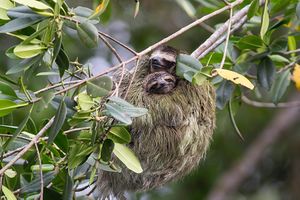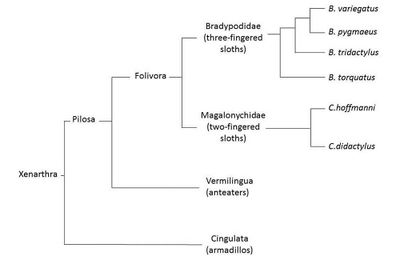Sloth evolution: Difference between revisions
| Line 20: | Line 20: | ||
==Microbiome== | ==Microbiome== | ||
Sloths have a mutualistic relationship with moths and algae that live in their fur <ref>https://royalsocietypublishing.org/doi/full/10.1098/rspb.2013.3006</ref>. The algae that grows in sloth fur not only camouflages the sloths in the tree canopy, but also provides a source of nutrients for the sloths. The algae | Sloths have a mutualistic relationship with moths and algae that live in their fur <ref>https://royalsocietypublishing.org/doi/full/10.1098/rspb.2013.3006</ref>. The algae that grows in sloth fur not only camouflages the sloths in the tree canopy, but also provides a source of nutrients for the sloths. The algae is rich in lipids and aids in digestion. This is essential for the sloth, because they only defecate once a week. If they do not have regular bowel movements, this increases the mass of the sloth, and can increase the risk of falling from the tree. <br></br> The amount of algae that grows in a sloth's fur is dependent on another organism: the moth. | ||
==Conclusion== | ==Conclusion== | ||
Revision as of 02:46, 2 December 2019
Introduction
Despite their similar appearances, the rise of modern sloths is an interesting story of convergent evolution. There are two families of sloths, the two-toed sloth and the three-toed sloth, but there are six different species total. Two-toed sloths belong to the genus Choloepus and three-toed sloths belong to the genus Bradypus. Known for their slow movements and inefficient digestive systems, these creatures populate South American and Central American rainforests. Their diets mainly consist of leaves and fruits. All species of sloths spend their time in the rainforest canopy, spending between 15-20 hours a day sleeping, and only venturing to the floor in order to defecate[1]. The forest floor is full of predators that sloths mainly avoid by hiding in the forest canopy. Their slow movements are due to their extremely slow metabolism, as they attempt to conserve energy by controlling movement speed. Sloths are solitary in nature, and spend most of their lives alone. The mating habits of sloths are unique, as they spend majority of their time in the trees, meaning they mate and give birth in the trees [2]. A female will call to attract a male, and the males that find her will fight in order to gain access to the female.

The evolution and microbiota of sloths are unique due to the species' ancestors and the various fungi and bacteria that populate the coarse fur of the animal. The evolution of sloths is interesting because two and three toed sloths appear very closely related, but they have vastly different ancestors, meaning that they evolved through convergent evolution. It was previously believed that these two groups of sloths diverged from the same ancestor, but this has recently been disproven. A better example of divergent evolution would be the evolution of dog breeds. The microbiota of sloths are the microorganisms that live within or on the sloth. Both the fur of the sloth and the digestive system are made of microorganisms, including bacteria, that the sloth benefit from through a mutualistic relationship.
Genetics/Evolution
Two-toed and three-toed sloths subside on the same diet and belong to the same order, Pilosa. Phenotypically, they appear almost identical, with the main distinguishing feature being their number of toes. These similar features would make them appear very closely related. However, these two sloths do not belong to the same family. Besides the difference between the number of toes each species has, they also differ in the number of vertebrae in their spines and several other morphological features. By examining the traits of the sloths like locomotion and suspensory posture [3], it was discovered that the Bradypus and Choloepus species evolved through convergent evolution, which is where organisms with different ancestors or from different periods evolved similar phenotypical traits. In all species of sloths, the hands and claws have changed over time to resemble hooks that are used in order to hang from trees with limited effort. The ligaments and muscles of the sloth are not strained when hanging from the trees, another important evolutionary adaptation of the sloth.

Further research examining the collagen in fossils has also proved the convergent evolution of sloths [4]. The collagen was used to recreate the proteins of the extinct animals. Through this process, it was revealed that the two-toed sloth is grouped with Mylodontidae, which encompasses ground sloths, including the giant land sloth [5]. The three-toed sloths were grouped as megatherioids instead of in the Mylodontidae family. This suggests that two and three-toed sloths are not closely related. Instead, they evolved to have similar phenotypes through convergent evolution.
Microbiome
Sloths have a mutualistic relationship with moths and algae that live in their fur [6]. The algae that grows in sloth fur not only camouflages the sloths in the tree canopy, but also provides a source of nutrients for the sloths. The algae is rich in lipids and aids in digestion. This is essential for the sloth, because they only defecate once a week. If they do not have regular bowel movements, this increases the mass of the sloth, and can increase the risk of falling from the tree.
The amount of algae that grows in a sloth's fur is dependent on another organism: the moth.
Conclusion
Overall text length should be at least 1,000 words (before counting references), with at least 2 images. Include at least 5 references under Reference section.
References
- ↑ https://www.livescience.com/27612-sloths.html
- ↑ https://www.livescience.com/27612-sloths.html
- ↑ https://link.springer.com/article/10.1007/s10914-011-9174-x
- ↑ https://www.nature.com/articles/s41559-019-0909-z
- ↑ https://www.nature.com/articles/s41559-019-0909-z
- ↑ https://royalsocietypublishing.org/doi/full/10.1098/rspb.2013.3006
Edited by Cassandra Lis, student of Joan Slonczewski for BIOL 116 Information in Living Systems, 2019, Kenyon College.
